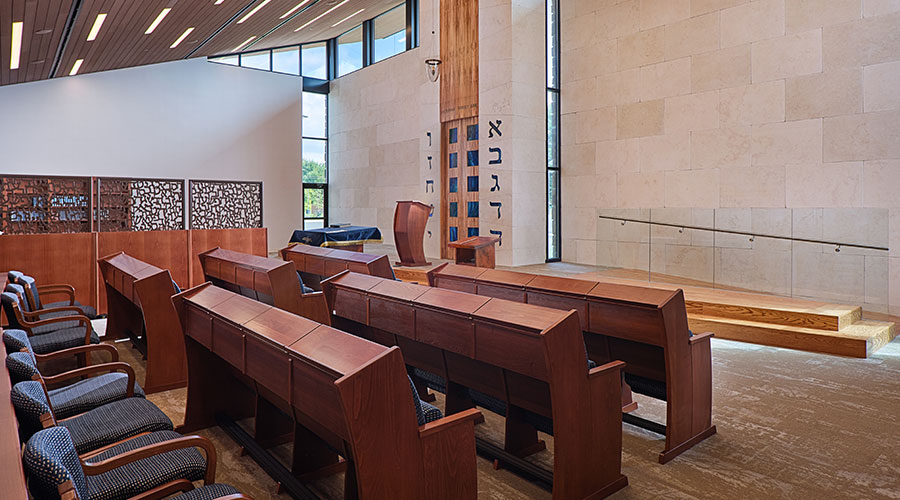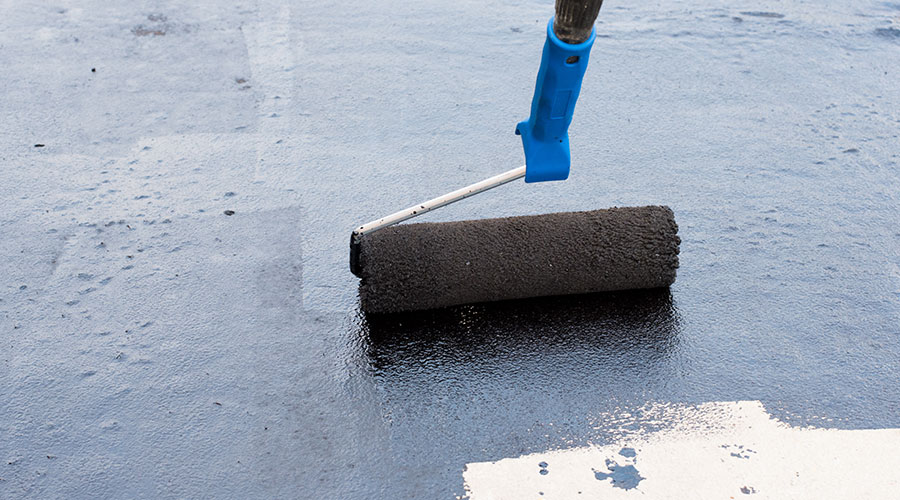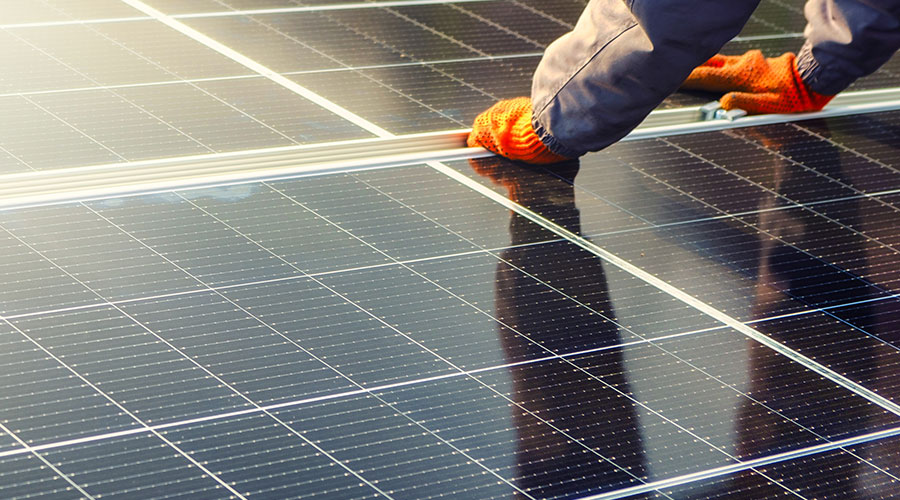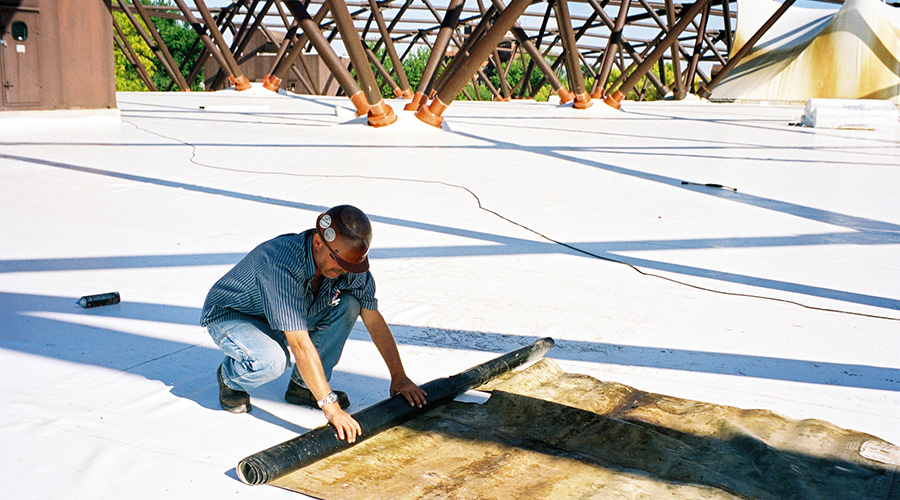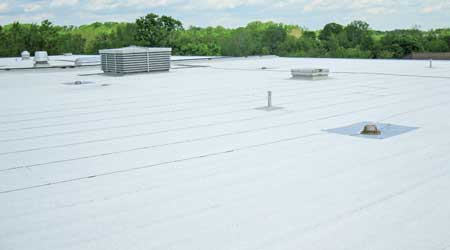 Cool roofs contribute to community resilience by helping mitigate the urban heat island effect.Hoffman Architects
Cool roofs contribute to community resilience by helping mitigate the urban heat island effect.Hoffman ArchitectsThe Resilience Benefits of Cool Roofing
Greater durability, keeping a building cooler, and contributing to community resilience are all ways cool roofing is itself a resilience strategy.
Conventional low-sloped roofing assemblies can be a significant source of stress on the resilience of both the asset and the community. On warm days, such coverings absorb sunlight, holding that energy in the form of heat within the assembly, transferring it into the building and warming the surrounding air. Heat that is absorbed into the building results in increased energy consumption and deterioration of building components due to thermal fatigue. Insulation can slow this transfer but will not eliminate it. These roofs can be as much as 50 degrees Fahrenheit warmer than the outside air temperature, contributing to urban heat island effect and taxing community resources.
By contrast, a cool roof is one that resists the absorption of energy by reflecting much of the sun’s radiation and efficiently emitting thermal radiation through the use of coatings or materials that combine reflectivity and infrared emittance (both measured on a scale of 0 to 1 and called the roof’s “radiative properties”). A cool roof can reflect 80 percent of solar radiation without warming the atmosphere, leaving a roof that might be only 5 to 10 degrees Fahrenheit warmer than the surrounding air. Such roofs can lower energy costs 10 to 15 percent by reducing the need to air condition a building using electricity during peak demand times, when such costs are 30 to 70 percent higher.
The result is not just an increase in the resilience of the building, but of the surrounding community, by decreasing demand on available resources and infrastructure. The widespread use of cool roofs can also have a cumulative effect on the temperature of the planet.
The application of resilience measures may come with unanticipated consequences, however. Maintaining cool roof performance, for instance, requires maintenance because the radiative properties can diminish over time due to the accumulation of soil and discoloration of the roof’s surface. Concerns have also been raised about the use of cool roofs in colder climates. Because the roof will not transfer as much thermal energy into the building, the location of the dew point (the temperature at which water in the air will change from vapor to liquid) on the interior may change, particularly in the winter, when the humidity differential between interior and exterior is often higher due to mechanical heating, resulting in condensation.
The efficacy of cool roofs in colder locations has also been a topic of discussion because these are “heating climates.” The term means exactly what you’d think it might: in a heating climate, there are more annual “heating degree days” than “cooling degree days.” While building codes have very specific definitions for these conditions, simply stated, a heating climate is one in which we spend more days heating our building than cooling it. If we spend most of our time heating a building, why would we want to reduce the heat we gain from the sun? The answer lies in the types of energy we use and the amount of heat we get from the sun during the winter.
Electricity is the most common form of energy used to cool a building, while heating is often achieved by alternative sources, such as natural gas. Because natural gas is less expensive than electricity (particularly during peak demand times), on average it costs less to heat a building than to cool it. In addition, the amount of energy we get from the sun in the winter is much less than that in the summer, due to factors like shorter days, sun angle, cloud cover, and snow accumulation. Ultimately, the deleterious effect that a cool roof has on the performance of a building in colder climates is negligible, and the general consensus is that the use of these assemblies is beneficial regardless of location.
Measuring cool roof resilience
While helping to mitigate climate change and preserve our available resources are admirable goals, many building owners and operators are understandably interested in the extent to which resilience measures will also lower operating costs. There is substantial data to support the assertion that cool roofs lower utility costs by decreasing electricity usage during peak demand periods. Recognizing the benefits of cool roofs in cutting electricity costs and easing the burden on energy infrastructure, many governing authorities are offering incentives to building owners for the installation of cool roofs on their facilities. The federal government has developed online tools, such as Oak Ridge National Laboratories’ “Cool Roof Calculator,” which “estimates cooling and heating savings for flat roofs with non-black surfaces” for specific locations within the United States.
Building owners may obtain more specific data regarding operating savings that may be realized by the installation of a cool roof (or a series of similar resilience measures) through a site-specific comparison of current utility costs and the efficiency anticipated from the subject improvements. This is generally accomplished through the collaborative effort of a mechanical engineer and a building enclosure consultant.
It should also be noted that the use of cool roof assemblies can extend the service life of building components by reducing thermal fatigue, further lowering life-cycle costs and preserving embodied energy.
Sensible resilience
The world is changing before our eyes. Climate change is real, our infrastructure is aging, available energy supplies are in ever-increasing demand. How we address these challenges will affect how we live into the next century. Our ability to respond to adversity lies in our resilience.
On both new and existing structures, simple measures like the installation of a cool roof can improve asset resilience by reducing energy usage and operating costs, extending the life-cycle of building components, and preserving the embodied energy of the built environment. The financial benefits of installing a cool roof on a facility are measurable, but the aggregate impact on community resilience – the reduction of greenhouse gas emissions, the mitigation of urban heat island effect, the lessening of the flow of materials into the waste stream, and the preservation of our existing infrastructure - is no less of a consideration.
Given the challenges, even small changes seem essential. Particularly when things are heating up.
Craig A. Hargrove, AIA, LEED AP (c.hargrove@hoffarch.com) is senior vice president and director, architecture with Hoffmann Architects, an architecture and engineering firm specializing in the rehabilitation of building exteriors. As manager of the firm’s New York office, he oversees demanding building envelope projects, leading project teams in developing cost-effective solutions for roofs, facades, windows, and plazas that meet energy performance and resiliency goals.
Related Topics:






